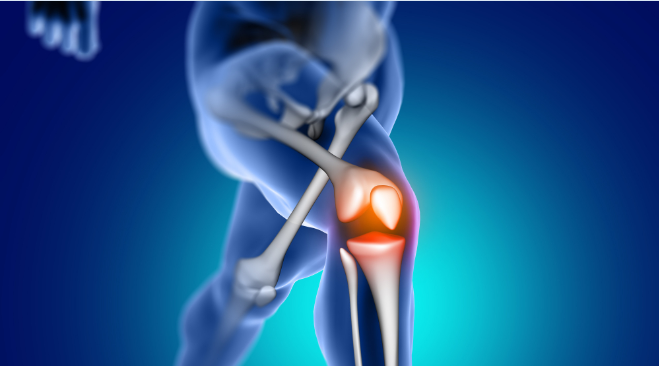
What is a TKR?
By: Dr. Abe Kopolovich, DPT, MBA, JD-IP
Who should go for total knee replacement?
A patient should consider surgery when there is intolerable pain in spite of painkillers. One should consider surgery when there are radiological signs of arthritis that affects one’s lifestyle.
According to Dr Paul McNamara, consultant orthopaedic surgeon, Medcare Orthopaedics and Spine Hospital, Dubai, patients need knee replacement for a variety of reasons, which could be attributed to injury, osteoarthritis, sedentary lifestyles and so on. Knee joint is worn off when the cartilage cushion between the bones wears away and the patient’s articular cartilage in the knees is damaged, or when the patient finds it extremely hard to move as the bones rub and crush together causing pain. That is when the patient needs to be fitted with an artificial prosthesis to alleviate pain.

Evolution of TKR
Dr McNamara said there was not much change to the types of prosthesis used. “While the basic mechanics of knee replacement have remained the same we have Titanium chromium alloy with polyethylene cushioning in prosthesis that provides high extension and flexion range and our techniques have advanced so much that we get the patient moving within five hours of surgery. In a regional special, we have the Arab Knee prosthesis, which has a slightly more pronounced slope allowing the patient to kneel. But all prostheses enable the patient to have a smooth flexion and extension movement at the knee joint, post the surgery.”
Dr McNamara added, “The greatest deterrent to knee replacement is the fear that people have. In the West, we have up to 15-16 TK surgeries being conducted in a single unit of any hospital as knee replacement is all about independence. Patients do not want to go on wheelchairs and prefer to opt for TKR. While here, I have seen many people preferring family members to push a wheelchair and keep putting off the surgery. This is detrimental to the patient as once he is confined to the wheelchair and movement gets restricted, there is too much muscle loss, making knee replacement more challenging. We want patients to go in for TKR as soon as possible as average lifespan of the prosthesis is easily 20-25 years and one can have a revision surgery after that. But it is important not to lose your muscle tone and be active and TKR provides that privilege to the patient immediately.”
Step-by-step procedure in a TKR
Dr NcNamara explained that in most cases, TKR did not replace the entire kneecap, but the prosthesis made of titanium and polyethylene was used as a disc to cushion the space between the femur and tibia in a manner that the patient could have complete extension and flexion without pain. He added that TKR not only involved the bones but also the soft tissues around the knee cap which usually tightened up with repeat injury and friction and have to be released and complemented with the prosthesis to give complete mobility to the patient.
The patient recovery takes about 5-6 hours after which the patient is allowed to move a little. If everything is stable and patient is able to move without pain, he or she is discharged the second day after surgery.
Quick recovery key to knee health
Patients of knee replacement are not required to be in the hospital for ten days as was conventionally expected. With smaller incision, lesser use of general anaesthesia and more use of local and regional anaesthesia in a layered way, all throughout the surgery, the patient is able to get on his feet merely 5-6 hours after surgery and can be discharged the next day, said Dr McNamara. The quicker recovery means better circulation and more dynamic healing of the surgery site.
Dr McNamara explained, “Now, during the surgery we use regional and local anaesthesia and minimise use of opioids as that confuses and disorients patients. I use a local anaesthesia at the site of the incision, another at the back of the knee and a third in the muscle towards the end of the surgery. These multilevel anaesthetics, help the patient feel less pain and he gets moving within hours of the surgery. That helps in preventing clots and also gets the joint mobile and is a great contributor to the rapid recovery. In a couple of years knee replacements will get to be day care procedures as we progress to more advanced techniques.”
What’s the success rate and lifespan of a prosthesis?
With superior prosthesis and better knee dynamics post-surgery, the lifespan of these replacements ranged from 20-25 years. “Therefore, we advise patients not to suffer in pain and discomfort and opt for a replacement if they require it. The surgeon will assess your condition and advise if you require total or partial knee replacement to have a superior and pain free quality of life.”
Who should go for total knee replacement?
A patient should consider surgery when there is intolerable pain in spite of painkillers. One should consider surgery when there are radiological signs of arthritis that affects one’s lifestyle.
According to Dr Paul McNamara, consultant orthopaedic surgeon, Medcare Orthopaedics and Spine Hospital, Dubai, patients need knee replacement for a variety of reasons, which could be attributed to injury, osteoarthritis, sedentary lifestyles and so on. Knee joint is worn off when the cartilage cushion between the bones wears away and the patient’s articular cartilage in the knees is damaged, or when the patient finds it extremely hard to move as the bones rub and crush together causing pain. That is when the patient needs to be fitted with an artificial prosthesis to alleviate pain.
Types of knee replacement surgeries
In the last few years, TKR has progressed from minimally invasive arthroplasty to MRI or CT-navigated replacements. Advanced techniques such as the 3D knee are making the surgery more sartorial. Surgeons say the 3D printed knee fits the patient as per his or specific anatomy and helps in the preoperative planning process contributing to greater precision and a superior outcome. According to Dr McNamara, the success rate of TKR is nearly 98 per cent with only two per cent risk of failure.

Common Questions
- Why is the knee one of the most important aspects of our physique in terms of lending body balance and managing weight distribution?
After our main torso, the hip, knee and ankle are the main weight bearing joints. The knee is the most crucial mechanical and anatomical axis that balances the body’s weight with equal distribution.
The knee is a joint between the two major portions of our lower limb — the femur and the tibia and it is supported by cartilage, meniscus and However, if the knee is misaligned, injured or not in the correct groove, than this becomes the most major factor in affecting one’s gait, balance and be a pain trigger.
- At what age do our knees begin to trouble us and why?
There is no specific age for knee trouble. A child who suffers a fall and damages a knee can have trouble at the age of two; someone who gets a tumour or injury can have knee trouble. However, it is a documented fact that after 30 when the bone mass declines, we need to be careful about our knee health. I women the problem compounds after 40-45 years closer to menopause with the fall in the oestrogen hormone. This can trigger osteoporosis and affect knee health more.
- They say obesity is one big factor for knee health, how does it affect knees?
Obesity affects the knee cartilage by two mechanisms. First, it increases the load placed on the knee joint, which increases stress and lead to gradual damage of cartilage lining the joints. Being overweight has also been associated with higher rates of osteoarthritis of the hands which does not carry the weight of the body. This suggests the involvement of a circulating systemic factor as well that causes damage to the cartilage all over the body.
Studies have shown that the risk of developing knee osteoarthritis is 4 to 5 time more in obese compared to non-obese people and for a woman of normal height, for every 5kg weight loss, the risk of knee osteoarthritis dropped by 50 per cent.
- Is there a way to keep our knee health perfect for our entire life? Please share some top tips
Although there are some risk, factors that we cannot control that may increase the chance of developing knee osteoarthritis for example, age, gender and heredity, there are things that we can do to help prevent it or at least minimise its severity.
- Control weight:If you are at a healthy weight, maintaining that weight may be the most important thing you can do to prevent osteoarthritis. If you are overweight, losing weight may be your best protection against the disease.
- Exercise:Low-impact exercise can improve joint health. Look for activities that include strength training and stretching in addition to aerobic exercise. Strengthen the muscles that surround the knee as strong muscles mean less stress on the joint itself.
- Early treatment of knee problems:The presence of bow -legs or injury of a knee ligament or cartilage can all lead to progressive damage to the knee cartilage. Thus, early treatment of such conditions will help you preserve the cartilage.
- Is there a way to keep our cartilage in good health for life?
One must have an active lifestyle, be mobile and have a healthy diet rich in antioxidants that can help minimise the adverse impact of oxidation and neutralise the free radicals.
For better cartilage health, it is advisable to get hyaluronic injections, use Platelet Rich Plasma Therapy, which can help in slowing down the deterioration in Stage, One, two and three of osteoarthritis. Although not really ratified by the FDA, a regular use of glucosamine chondroitin can also help in knee health and slow down the wear and tear.
- At what age does it become important to get knee replacements and why?
When the space between the femur and tibia narrows due to thinning of cartilage, so much so that the bone rubs on bone, it causes excruciating pain and discomfort. When this cannot be managed clinically, then it is time for getting an assessment to see if one is a candidate for knee replacement.
If non-surgical treatments like medications and using walking supports are no longer helpful in relieving knee pain, you may need to have total knee replacement surgery. Most patients who undergo total knee replacement are age 50 to 80 years old but you need knee replacement whenever you develop problems of mobility due to knee damage, which can be earlier too. On average, a total knee replacement lasts about 20-25 years, so if you have the procedure in your 40s, you will most likely need to have another — or a revision — surgery later in life.
On the other hand, delaying surgery is not a good idea because osteoarthritis limits mobility and this can lead to other health problems physically and psychologically related to being sedentary. In addition, when knee replacement is delayed, people do not get as much function back as they would have if they had the surgery sooner.
- What is the difference between total and partial knee replacement and what is the deciding factor on which kind of replacement a patient needs?
In a total knee replacement, the surgeon removes the entire surface of the joint and replaces it with artificial parts. However, in partial knee replacement, either the inside (medial) or outside (lateral) compartments of the knee joint are removed and replaced with artificial parts.
Partial knee replacement tends to be performed if osteoarthritis affects only one-half of the knee joint. Because partial knee replacement retains most of your knee tissue, you are still susceptible to meniscal tears and progression of arthritis in the rest of the knee. When a partial knee replacement fails, it can be converted to a full knee replacement.
- Can an artificial knee replace a health knee joint completely or are there issues that will always be present with an artificial knee?
After knee replacement, you can resume most of your daily activities. Low-impact fitness activities, such as golfing, bicycling, and light tennis will help increase the longevity of your knee but avoid high-impact activities such as jogging and playing football. Patients who have undergone replacement are advised against heavy lifting, especially during squats and similar exercises, which can exert pressure on your joints.
- Under what circumstances is the artificial knee contraindicated (or who cannot get the knee replacement)
Doctors do not recommend knee replacement to people who are bedridden and are not mobile due to neurological problems. Such individuals who do not use the knee replacement can develop clots and even infections with a lack of movement which can be life threatening. People who get knee replacements must be mobile and indulge in light to moderate exercises.
For More information how physical & occupational therapy can help call Therapy-In-Motion (718) 435-7000 or visit us at www.Therapy-In-Motion.com



